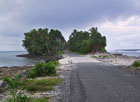
Trouble in Paradise 2004
Distributed by Documentary Educational Resources, 101 Morse Street, Watertown, MA 02472; 617-926-0491
Produced by Gilliane Le Gallic
Directed by Christopher Horner
DVD, color, 73 min.
College - Adult
Anthropology, Area Studies, Environmental Studies, Geography
Date Entered: 04/20/2005
Reviewed by Karen MacArthur, Kansas State UniversityThis engaging, informative documentary of Tuvalu and its modern daily life is presented in an easily-followed, well-paced style rather than a dull series of facts. It begins with an overview of the nation, namely its geographic location, population, size, and brief history, and later gives details about religion, economics, traditions, and modern influences on the country. It ends with the effects caused by changing weather patterns and the projected demise of the islands caused by elevated sea levels. The strength of this documentary is the opportunity to see the everyday life and how much the citizens value their nation and heritage coupled with real examples of how they are being affected by the changes in weather. Viewers are not asked to imagine the transformation the inhabitants will endure - we see what is happening to real people without speculation. Through various interviews we learn about salt water intrusion and its effects on crops, the pollution caused by importing more food products as crops fail, erosion, increases in the number of typhoons, and the high tides that flood the houses.
The language of the documentary is very general and viewers need not be familiar with technical terms related to geography or weather; this film is not for a specialized audience. Towards the later part of the film supporting evidence for global warming is introduced, including the results from the Australian National Tidal Facility’s sea level gauge that indicate a rise in sea level of 4mm per year. For a nation averaging 5 feet above sea level, they have cause for concern. Interviews with a representative of the meteorological services contribute her findings on the increase in tropical cyclones and flooding since they have been tracked in 1993.
Sound, video, and editing are excellent and all interviews are in English with no subtitles. This documentary is just as much an area study as it is a study of the effects of climactic changes and will function equally well in either focus. For use with a study of geography, however, supplemental information regarding global warming would be helpful as the only information regarding this in the documentary refers very, very briefly to emissions from automobiles and some industries: the audience is assumed to be familiar with the concepts. This documentary is recommended for use in learning about Tuvalu in general and seeing the effects of climactic changes in particular.